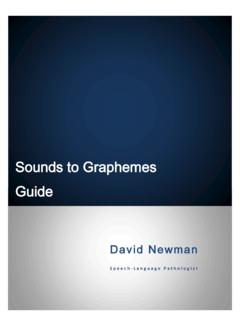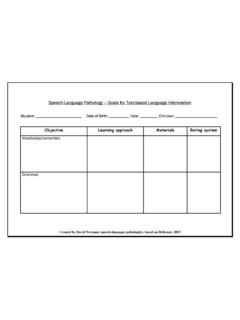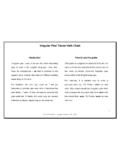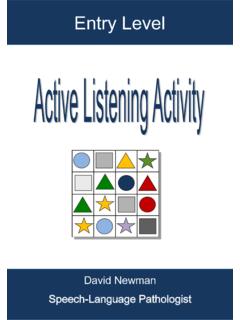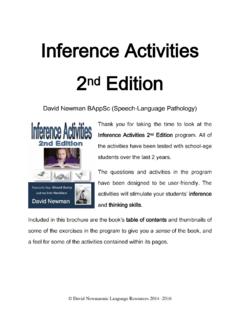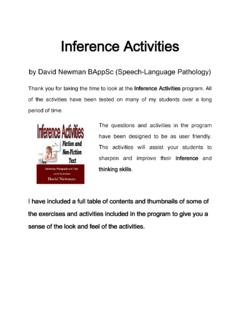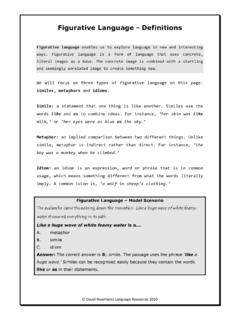Transcription of Multiple Oppositions Therapy Guide - Speech-Language …
1 Created by David Newman Speech-Language pathologist Multiple Oppositions Therapy Guide This Guide is a brief introduction to Multiple Oppositions intervention. This Guide is quite limited in its scope. For a more in depth and comprehensive description of Multiple Oppositions Therapy , please consult Lynn William s SCIP, Sound Contrasts in Phonology: Evidence Based Treatment Program. Created by David Newman Speech-Language pathologist Multiple Oppositions Multiple Oppositions is a linguistic method of speech Therapy that is highly useful as an intervention for students with moderate to severe phonological disorder. It is based on a contrastive model of speech Therapy and is similar in nature to minimal pairs Therapy .
2 In minimal pairs treatment, one target sound is contrasted with an error sound or deletion For example, /s/ - /t/, or sun becomes tun. In minimal pairs Therapy , contrastive word pair cards are created to train the child the contrast sound to /s/. Some simple examples are shown below. In our example, the phoneme /s/ is substituted by /t/. So the child may incorrectly produce I feel tick, for I feel sick. sick - tick see - tea sore - tore Children who present with significant speech errors may substitute several or many sounds with a single sound. This is known as a phoneme collapse. For example, the sounds /k p h tr/ may all be substituted by /t/. We describe this as a 1-4 phoneme collapse, where 4 phonemes are substituted by a single phoneme, the phoneme /t/.
3 If a child with this particular phoneme collapse attempted to say, My cat likes to purr when he s happy, this sentence may be produced as, My tat ti to turr when he tatty. The Multiple Oppositions approach to speech Therapy targets up to 4 targets from a child s phoneme collapse, which will be contrasted with the child s error substitute. As in our previous example, the substitute /t/ phoneme is here contrasted with the phonemes /k p h tr (cluster)/. We have targeted 4 separate vowel/consonant combinations. tie - Kai, pie, hi, try Created by David Newman Speech-Language pathologist tea - key, pea he tree tar - car, par, ha, trar tap - cap , pap, hap, trap Note that some of the target sounds are not real words and are referred to as non-words.
4 Non-words can be as effective as real words in speech Therapy . We are not teaching content with the Therapy cards but targeting specific sounds. Prior to beginning speech Therapy , the clinician will make a series of cards. The cards will come in groups of five where the sound substitute card will be in a gray text box, whereas the 4 target sounds will be in white text boxes. The series of five words will also be of a particular colour. For our tie Kai, pie, hi try example the cards are presented in light yellow. Colour coding the cards is a handy means of grouping the card sets. Colour coding becomes important when up to 60 cards are mixed on a table and you want to quickly separate the cards into their proper groups.
5 Note that the words, as arranged on the rating progress chart, follow the same colour code to assist you in writing the correct data on the data sheet. Created by David Newman Speech-Language pathologist Multiple opposition Card Creation A feature of the Multiple Oppositions Therapy model is that each child s unique presentation of speech errors is taken into account during the assessment phase. To address your child s unique speech errors, it is important to construct a series of contrastive words and non-words that cater to and are specific for your child. Card Creation The following cards are examples of what can be created for a specific sound set. The images were downloaded from clipart and the card borders were easily made using the textbox feature on Microsoft word.
6 Note that light yellow has been added to each picture box border to aid identification of the word set. Word Selection It is important to select words that contrast with the substituted word. In our example above the child substitutes the /t/ phoneme for the phonemes / k h p tr/. In this instance the /ei/ vowel was selected. In our example we were able to find three contrastive words that fit with tie and added a name, Kai. For other words we will occasionally need to revert to non-words and create a picture that will match with the non-word. You can invent a name for a person or invent a name for a monster, etc. A range of minimal pair contrastive words can be found on Caroline Bowen s website. Just do a google search and enter Caroline Bowen, minimal pairs, word lists.
7 Created by David Newman Speech-Language pathologist Multiple Oppositions Therapy Familiarization Training Multiple Oppositions is similar in principle to minimal pairs Therapy . As in minimal pairs, it is important to familiarize your child to the sequence of activities. Step 1: The parent/clinician sits at a table with the child. It is best to arrange seating so that the child is at eye level. The clinician arranges the five cards on the table and point to each in turn and begins This is a tie, this is a boy whose name is Kai, this man is waving hi, this is a piece of pie, and this is a man scoring a try. Step 2: Listen and Pick Up. The clinician spreads out the pictures of the word set on the table and says, Pick up the picture of the tie, pick up the picture of the pie, etc.
8 Feedback is provided if the child picks up the wrong card. For instance, You picked up the Kai card, not the tie card. Listen again, the word is Kai, which starts with /k/. Step 3: During this step, the child has an opportunity to be the teacher. The child arranges the cards in front of the clinician and the child prompts the clinician to pick up each card individually. The child is instructed to say, Pick up tie, Kai, hi, pie, try. The child is likely to articulate each word as tie causing semantic confusion. The role of the clinician at this point is important. If the child instructs the clinician to pick up the pie card but articulates tie the clinician needs to feign confusion and then provide specific feedback. The role of the clinician is to challenge the child to recognise that they have made an error.
9 Oh, you said tie, did you mean pie? Try saying that word again, pie. If the child continues to produce tie for pie provide feedback as necessary. Oh, I think you meant to say pie. Pie has the /p/ sound. Can you do the /p/ sound. I ll do the /p/ sound first and then you try, etc. Continue this sequence for all the other yellow cards in the set. Created by David Newman Speech-Language pathologist Word Imitation and Spontaneous Production Training At this level, your child is instructed to imitate the five words in the card set. The clinician provides focused feedback as necessary. The sequence is as follows: The child sits across from the clinician at a table, preferably at the same eye level as the clinician.
10 Alright Tom, today we re going to work on some words that have 4 different sounds. They are the same sounds we previously worked on. Are you ready? Hold the tie card beside your face so that your child can see it clearly. Model the word and emphasize the first phoneme in tie, so tie. Contrast tie with the first of the contrast cards, Kai. Say and clearly articulate tie and then Kai in quick succession. Your child then imitates the two contrasting sounds. Say, Your turn, and present the two contrastive cards. Praise your child s attempt and provide feedback as necessary. If your child simply produces tie for Kai feign semantic confusion and ask your child to repeat the word, Kai, with That didn t sound quite right.
